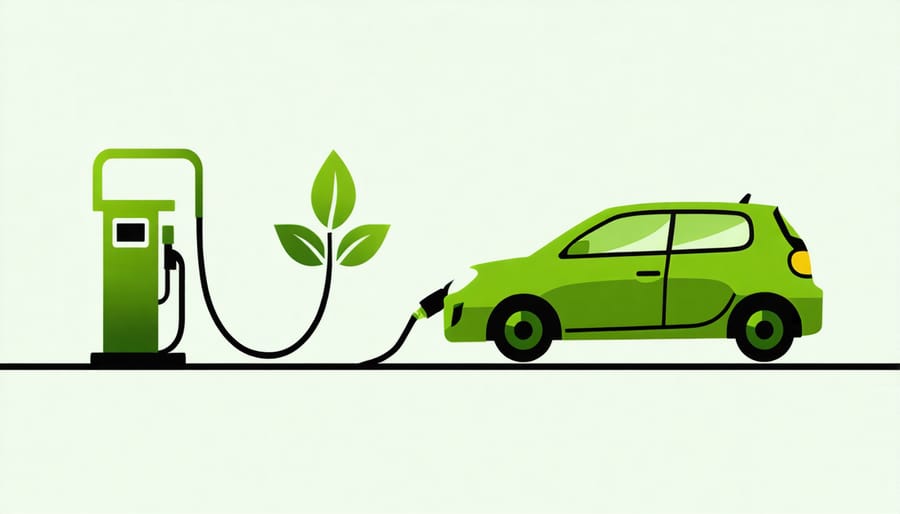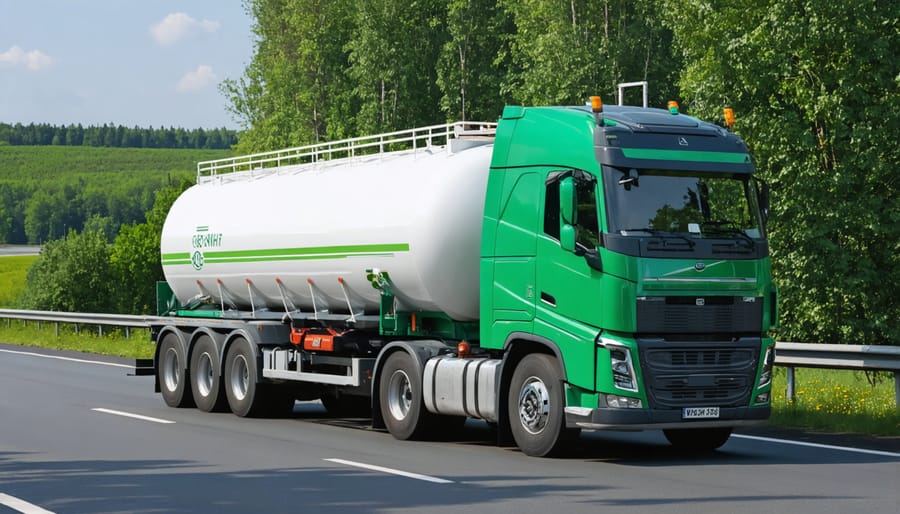Transport is the backbone of our economy and way of life, but it’s also a major contributor to climate change. To avoid catastrophic global warming, we must rapidly decarbonize how we move people and goods. Bioenergy offers immense potential to slash emissions from cars, trucks, ships, and planes by replacing fossil fuels with renewable, low-carbon alternatives like ethanol, biodiesel, and biojet fuel made from organic waste and purpose-grown crops. Forward-thinking policies and investments can accelerate the transition, from vehicle emission standards to biofuel production incentives. We have the solutions – now it’s time for bold action to make clean transport a reality. The road ahead is challenging, but a sustainable future is within reach if we embrace bioenergy’s power to transform transportation.
Biofuels: A Cleaner Alternative to Petrol and Diesel

Ethanol and Biodiesel
Ethanol and biodiesel are the two primary biofuels used in transportation, offering a cleaner alternative to fossil fuels. Ethanol, made from sugarcane or corn, is blended with gasoline to power cars and light trucks. In Australia, the most common blend is E10, containing 10% ethanol, which can be used in most petrol vehicles without modifications. Higher blends like E85 are also available for flex-fuel vehicles. Biodiesel, produced from vegetable oils, animal fats, or recycled cooking oils, can power diesel engines in cars, trucks, buses, and agricultural machinery. Blends up to B20 (20% biodiesel) are compatible with most diesel engines, while higher blends may require some modifications. By using these renewable biofuels, we can significantly reduce our reliance on petroleum and contribute to reducing carbon emissions in the transport sector. As Australia continues to invest in biofuel production and infrastructure, ethanol and biodiesel will play an increasingly important role in our transition to a more sustainable future.
Australian Biofuel Success Stories
Several Australian transport companies have successfully adopted biofuels, demonstrating their commitment to sustainability and proving the viability of these renewable energy sources. For example, Qantas, Australia’s largest airline, has been using sustainable aviation fuel blended with traditional jet fuel on select flights since 2012, reducing greenhouse gas emissions by up to 80% compared to conventional jet fuel. In the public transport sector, the City of Sydney has been running its diesel bus fleet on a 20% biodiesel blend since 2019, resulting in a significant decrease in carbon dioxide emissions and improved air quality. These success stories showcase the tangible benefits of biofuel adoption and serve as an inspiration for other transport operators to follow suit in the journey towards decarbonization.
Biomethane: Fueling a Greener Heavy Transport Fleet

Advantages Over Fossil Natural Gas
Biomethane, a renewable fuel derived from organic waste, offers significant advantages over fossil natural gas in decarbonizing transport. By capturing methane emissions from sources like landfills, wastewater treatment plants, and agricultural waste, biomethane production prevents this potent greenhouse gas from entering the atmosphere. When used as a transport fuel, biomethane can reduce well-to-wheel emissions by up to 85% compared to fossil natural gas. This substantial reduction in carbon footprint makes biomethane a compelling alternative for fleet operators and individuals seeking to minimize their environmental impact. Moreover, as biomethane is produced locally from readily available waste streams, it enhances fuel security and reduces dependence on imported fossil fuels. By embracing biomethane, Australia can create a more resilient and sustainable transport sector while supporting the growth of a circular economy that turns waste into valuable energy resources.
Infrastructure Requirements
To support the widespread adoption of biomethane in heavy transport, a robust refueling infrastructure is crucial. This involves establishing a network of biomethane refueling stations along major transport routes, ensuring that vehicles can easily access renewable fuel. Collaboration between government, industry, and fuel providers is key to developing this infrastructure efficiently. Existing natural gas pipelines can be leveraged to transport biomethane, reducing the need for new infrastructure. Additionally, on-site anaerobic digestion facilities at truck depots and logistics centers can provide a decentralized approach to biomethane production and distribution. By investing in the necessary refueling infrastructure, Australia can accelerate the transition to cleaner, greener heavy transport powered by sustainable biomethane.
Bio-Powered Public Transit
Biofuel Buses and Trains
Biofuels like biodiesel and biomethane are increasingly being used to power city buses and passenger trains across Australia, significantly reducing carbon emissions in public transport. In Sydney, the bus fleet is gradually shifting to biodiesel blends, with some buses running on 100% biodiesel derived from recycled cooking oil and agricultural waste. Similarly, Melbourne’s tram network is exploring the use of biomethane to complement its electric trams, further cutting emissions. Regional trains in Victoria and New South Wales are also testing biodiesel blends, offering a more sustainable way to travel between cities. By embracing biofuels, Australian public transport is becoming cleaner, quieter, and more environmentally friendly, setting an example for other sectors to follow.
Municipal Success Story
The City of Brisbane has emerged as a trailblazer in sustainable public transit. In 2020, the city launched Australia’s first 100% bioethanol-powered bus fleet. The 120 buses run on fuel derived from locally-sourced sugarcane, reducing greenhouse gas emissions by up to 90% compared to diesel. This initiative has not only cut the city’s carbon footprint but also supports Queensland’s agricultural sector. Brisbane’s success demonstrates the viability of bioenergy in decarbonizing public transport, setting an inspiring example for other Australian cities to follow. With plans to expand the program and integrate other biofuels, Brisbane is paving the way towards a greener future for urban mobility.
Bioenergy Opportunities for Aviation and Maritime Transport

Sustainable Aviation Fuel (SAF)
Sustainable aviation fuel (SAF) is a game-changer for decarbonizing air transport. Made from renewable resources like agricultural waste, used cooking oil, and even algae, SAF can reduce lifecycle greenhouse gas emissions by up to 80% compared to conventional jet fuel. As Qantas and other Aussie airlines invest in SAF, the potential to significantly cut the carbon footprint of flying is immense. SAF is a “drop-in” fuel, meaning it can be used in existing aircraft without modifications, making it a practical solution for greening aviation. With supportive policies and increased production, SAF could power a more sustainable future for air travel, helping Australia reach its emissions reduction targets while keeping us connected to the world.
Green Shipping Initiatives
As the maritime industry seeks to reduce its carbon footprint, biofuels are emerging as a promising solution. Globally, shipping companies and ports are collaborating to develop and deploy sustainable biofuels for ocean-going vessels. In Australia, the Australian Maritime Safety Authority (AMSA) is working with industry partners to explore the potential of biofuels derived from feedstocks like algae, used cooking oil, and agricultural waste. These renewable fuels can significantly lower greenhouse gas emissions compared to traditional marine diesel. Ports in Sydney and Melbourne have already begun trials of biodiesel blends in tugboats and other harbor craft, demonstrating the feasibility of biofuels in real-world operations. As research advances and supply chains mature, biofuels are poised to play a crucial role in decarbonizing the shipping sector, contributing to Australia’s goal of net-zero emissions by 2050. With the right investments and policies, Australia can become a leader in sustainable marine biofuels, creating new opportunities for its agriculture and renewable energy industries while driving the transition to cleaner, greener shipping.
Paving the Way with Policy
Current Australian Policies
The Australian government has implemented several policies to support bioenergy in transportation. The Renewable Energy Target encourages the use of biofuels, while fuel quality standards mandate ethanol blending. Some states offer grants and incentives for bioenergy projects. For example, Queensland’s Biofutures Program invests in biofuel production and infrastructure. New South Wales has a Biofuels Act requiring a minimum percentage of biodiesel and ethanol in fuel sales. Victoria’s Renewable Energy Action Plan promotes sustainable bioenergy. These policies lay the groundwork for further decarbonization efforts in the transport sector, but continued support and investment are needed to accelerate the transition to cleaner fuels.
Policy Recommendations
To further accelerate the decarbonization of transport, policymakers should consider additional measures such as implementing stronger fuel efficiency standards, offering tax incentives for biofuel production and use, and investing in research and development of advanced bioenergy technologies. Governments can also lead by example, transitioning their own vehicle fleets to run on sustainable biofuels. Encouraging collaboration between industry, academia, and government will foster innovation and drive down costs. Public education campaigns can raise awareness about the benefits of bioenergy in transport, while infrastructure investments, such as biofuel pumps at service stations, will make it more convenient for consumers to choose cleaner fuels. By taking a multi-faceted approach, we can accelerate the shift towards a low-carbon transport future powered by sustainable bioenergy.
Conclusion
Bioenergy has the immense potential to revolutionize Australia’s transportation landscape, offering a sustainable solution to decarbonize Australia’s transportation sector. By harnessing the power of renewable biomass resources, we can significantly reduce greenhouse gas emissions, improve air quality, and create a more resilient and self-sufficient energy system. The diverse range of bioenergy applications, from biofuels for cars and trucks to biogas for public transport and aviation, demonstrates the flexibility and adaptability of this clean energy solution. With the right policies, investments, and public support, Australia can become a global leader in sustainable transportation, inspiring other nations to follow suit. As we embrace the transition to a low-carbon future, it is crucial that we recognize the vital role bioenergy can play in transforming our transport sector. By working together to promote and implement bioenergy solutions, we can create a cleaner, greener, and more prosperous Australia for generations to come.

